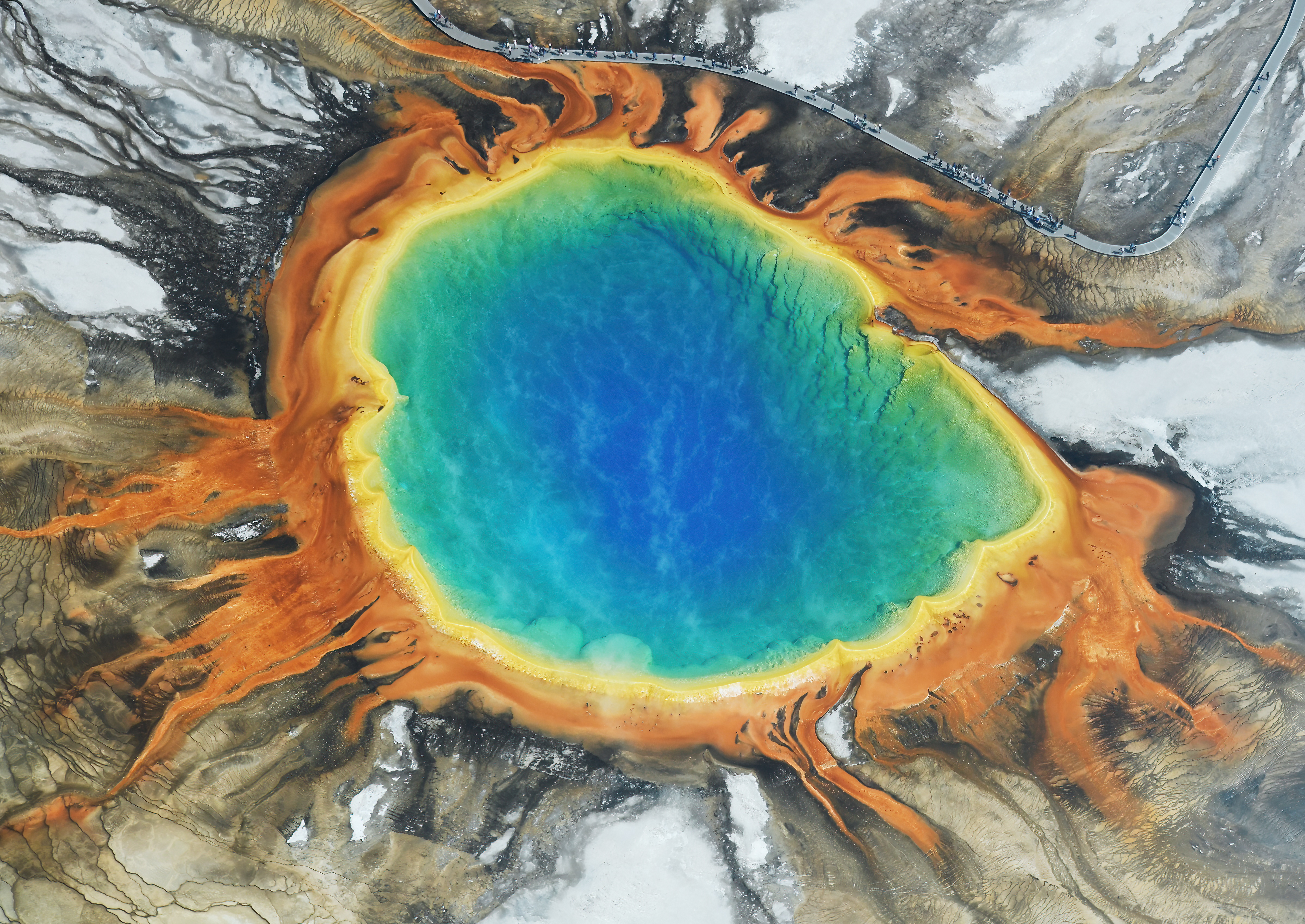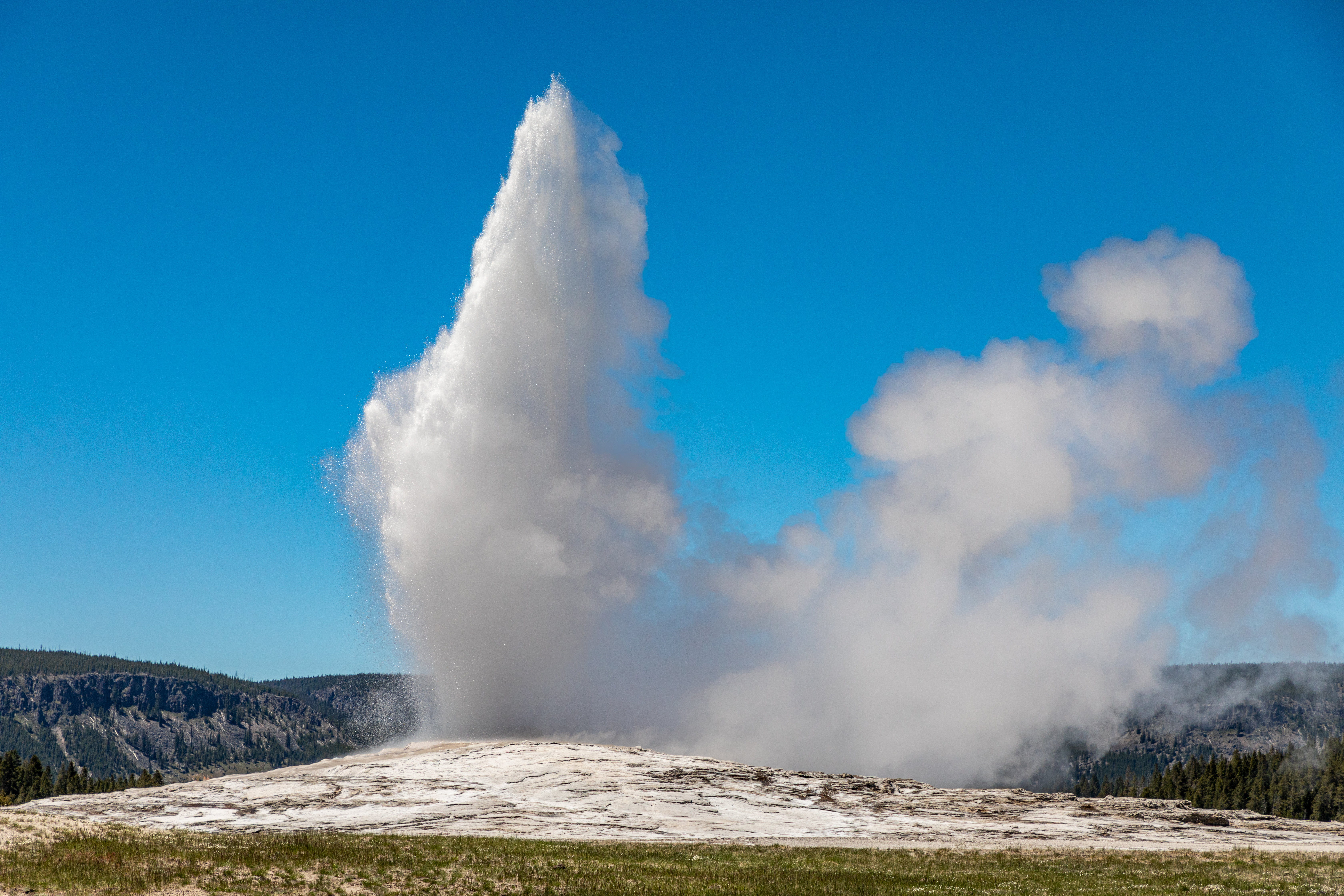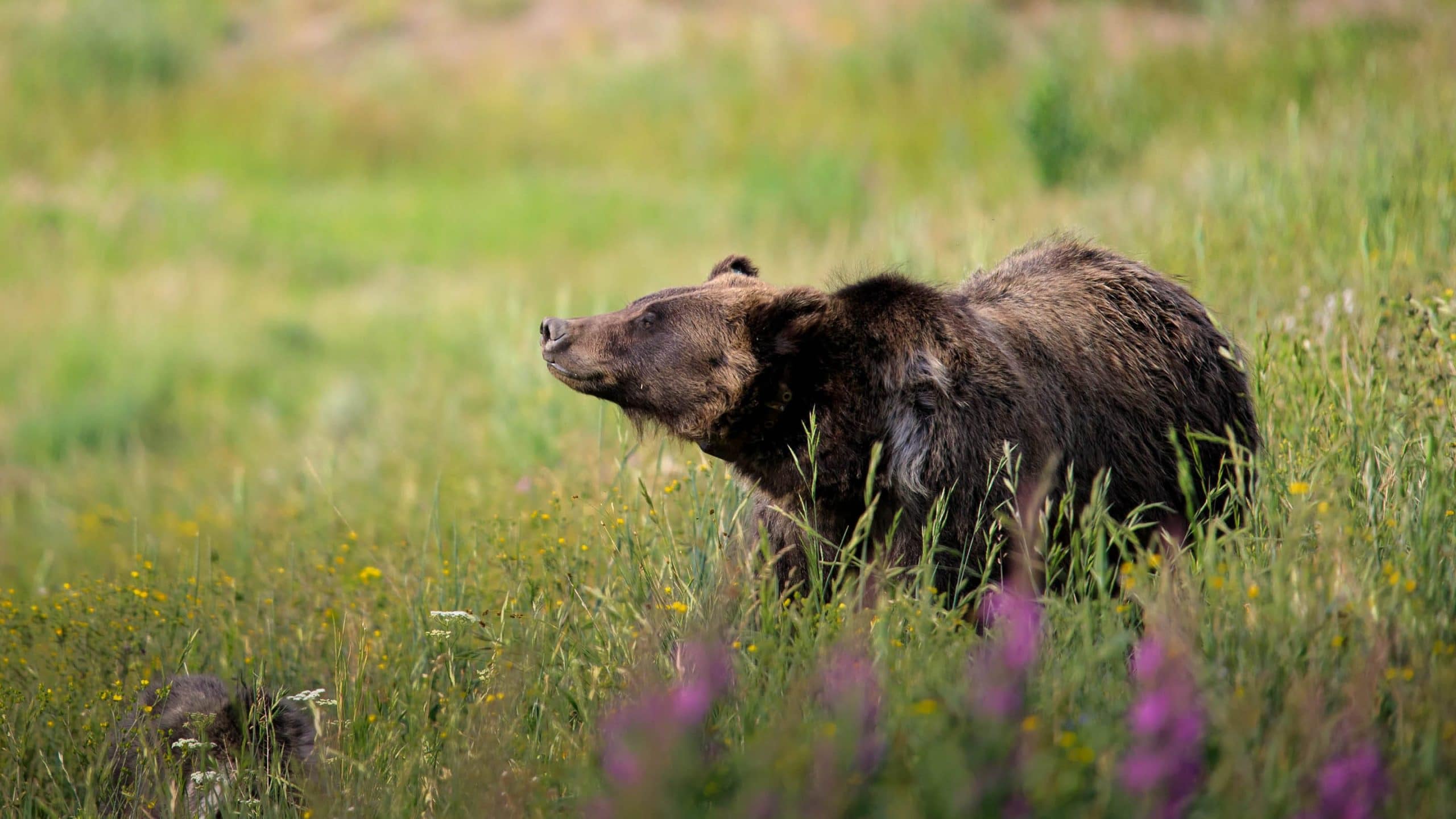.webp)
The Ultimate Guide to Facts About Yellowstone National Park: America's First Natural Wonder
Discover the incredible facts about Yellowstone National Park that make it America's most treasured wilderness. From explosive geysers to massive wildlife herds, I've spent countless seasons exploring this geological wonderland to bring you the most fascinating insights and personal experiences. Visit Nature Guests for more outdoor adventures and national park guides.
🌋 Geological Wonders and Supervolcano Facts

The most mind-blowing facts about Yellowstone National Park center around its geological foundation. Yellowstone sits atop one of the world's largest active supervolcanoes, creating a landscape unlike anywhere else on Earth. This massive caldera measures approximately 45 by 30 miles (72 by 48 kilometers), making it one of the largest volcanic systems in North America.
During my first visit to Yellowstone, I was astounded to learn that the park experiences between 1,000 to 3,000 earthquakes annually. Most are imperceptible, but they constantly remind visitors that we're standing on an active geological hotspot. The Yellowstone Caldera was formed by a catastrophic eruption approximately 640,000 years ago, which ejected over 240 cubic miles of material into the atmosphere.
Important Fact: Despite popular misconceptions, Yellowstone's supervolcano is not overdue for an eruption. Scientists estimate the probability of a catastrophic eruption in the next thousand years to be extremely low.
The park's elevation ranges dramatically, from a low point of 5,282 feet at Reese Creek to the towering Eagle Peak at 11,358 feet above sea level. This elevation diversity creates multiple ecosystems within the park's 3,472 square miles, making Yellowstone larger than Rhode Island and Delaware combined. The geological complexity extends to the park's borders, with 96% located in Wyoming, 3% in Montana, and 1% in Idaho.
What fascinates me most about Yellowstone's geology is how the underlying magma chamber heats the extensive groundwater system, creating the park's famous hydrothermal features. This underground plumbing system is so complex that geologists are still discovering new connections between distant thermal areas.
💧 Hydrothermal Features and Geysers

Among the most spectacular facts about Yellowstone National Park are its hydrothermal features. The park contains more than 10,000 hydrothermal features, including over 500 active geysers—more than half of all the geysers in the world. These incredible formations fall into five main categories: geysers, hot springs, mud pots, travertine terraces, and fumaroles.
Old Faithful, Yellowstone's most famous geyser, continues to amaze visitors with its predictable eruptions every 60 to 110 minutes. During my multiple visits, I've witnessed eruptions reaching heights of 130 to 185 feet, lasting between 1.5 to 5 minutes. What many visitors don't realize is that Old Faithful is just one of several predictable geysers in the Upper Geyser Basin.
🌊 Hot Springs
Grand Prismatic Spring, the largest hot spring in the US, spans 370 feet in diameter with temperatures reaching 189°F at its center.
🌋 Geysers
Steamboat Geyser holds the record as the world's tallest active geyser, with major eruptions reaching over 300 feet high.
The vibrant colors of Yellowstone's hot springs result from heat-loving bacteria called thermophiles. These microscopic organisms thrive in extreme temperatures and create the stunning rainbow rings around thermal features. During cooler months, I've observed how these colors intensify as the bacteria populations shift with temperature changes.
Yellowstone Lake, sitting at 7,733 feet above sea level, covers 131.7 square miles with 141 miles of shoreline. This massive body of water contains several underwater hydrothermal features, making it one of the highest elevation large lakes in North America. The lake's maximum depth reaches 430 feet, and it remains frozen for approximately half the year.
🐻 Wildlife Diversity and Conservation

The wildlife facts about Yellowstone National Park showcase one of North America's most intact ecosystems. The park hosts 67 species of mammals, including the largest concentration of mammals in the lower 48 states. This incredible diversity includes seven species of native ungulates and two species of bears—both black bears and the iconic grizzly bears.
During my early morning wildlife safaris, I've encountered the park's famous megafauna. The Yellowstone Park bison herd represents the oldest and largest public bison herd in the United States, with populations fluctuating between 2,300 to 5,500 individuals. These massive animals, weighing up to 2,000 pounds, are descendants of the plains bison that once numbered in millions across North America.
🦅 Avian Wildlife
Yellowstone supports 285 species of birds, with approximately 150 species nesting within park boundaries. The successful reintroduction of trumpeter swans represents one of the park's conservation victories. From my observations at Yellowstone Lake, these magnificent birds, with wingspans reaching 8 feet, have made a remarkable recovery from near extinction.
Essential Wildlife Viewing Gear
The park's predator-prey relationships create dramatic wildlife encounters. Gray wolves, reintroduced in 1995, now number approximately 95-100 individuals in 8-10 packs. I've witnessed the profound ecological impact of their return, observing how wolf predation has altered elk behavior and allowed vegetation recovery in riparian areas—a phenomenon scientists call the "trophic cascade."
Grizzly bears, listed as a threatened species, have populations estimated between 150-200 individuals within the Greater Yellowstone Ecosystem. These powerful omnivores can weigh up to 700 pounds and are most active during dawn and dusk hours. During my backcountry explorations, I've learned to identify bear signs and always carry bear spray as recommended by park rangers.
📚 Park History and Cultural Heritage
The historical facts about Yellowstone National Park reveal a rich tapestry of Native American heritage and pioneering conservation efforts. Established on March 1, 1872, Yellowstone became the world's first national park when President Ulysses S. Grant signed the Yellowstone National Park Protection Act, setting aside over 2 million acres "for the benefit and enjoyment of the people."
Long before European exploration, 26 Native American tribes have ancestral connections to the Yellowstone region. The Shoshone, Crow, Blackfeet, and other tribes traveled through these lands for over 11,000 years, hunting, gathering, and conducting spiritual ceremonies. The park contains more than 1,800 known archaeological sites, though less than 3% of the park has been systematically surveyed.
🏛️ Cultural Resources and Collections
Yellowstone's Heritage and Research Center houses an impressive collection of over 720,000 museum items, including 30 historic vehicles, more than 20,000 books and manuscripts, and millions of archived documents. During my research visits, I've been amazed by artifacts ranging from Native American tools to early park ranger equipment that tell the story of human interaction with this landscape.
💡 Did You Know?
The famous expedition led by Ferdinand Hayden in 1871 included photographer William Henry Jackson and artist Thomas Moran. Their documentation was crucial in convincing Congress to establish Yellowstone as a national park. Today, you can explore similar perspectives by visiting Joshua Tree National Park or discovering under-the-radar hiking destinations across America.
The park's infrastructure development tells a story of evolving conservation philosophy. The historic hotels and lodges, including the iconic Old Faithful Inn built in 1904, represent some of the finest examples of rustic architecture in America. These structures were designed to blend with the natural environment while providing visitor accommodations—a revolutionary concept at the time.
The establishment of the National Park Service in 1916 marked another crucial milestone in Yellowstone's history. The agency's mission "to preserve unimpaired the natural and cultural resources and values of the national park system for the enjoyment, education, and inspiration of this and future generations" continues to guide park management decisions today.
🎒 My Personal Yellowstone Experience
After visiting Yellowstone during all four seasons over the past decade, I've discovered that the most remarkable facts about Yellowstone National Park come alive through personal experience. My first winter visit transformed my understanding of the park's resilience and beauty, watching bison forge through deep snow while steam rises from nearby hot springs.
Seasonal Insights from My Visits
Spring (April-May): Wildlife activity peaks during birthing seasons. I've witnessed elk calves taking their first steps and bear cubs emerging from dens. The contrast between snow-covered peaks and valley wildflowers creates stunning photography opportunities.
Summer (June-August): Peak visitation brings crowds but also maximum accessibility. Early morning starts (5:30 AM) provide the best wildlife viewing and fewer crowds at popular thermal features.
Fall (September-October): Elk bugling season offers the most dramatic wildlife encounters. The golden aspen colors and crisp air make this my favorite photography season.
Winter (November-March): Cross-country skiing to thermal features reveals Yellowstone's most serene beauty. The park's winter silence, broken only by geyser eruptions and wildlife calls, creates an almost spiritual experience.
One of my most memorable encounters occurred during a backcountry hike to winter hiking locations when I observed a grizzly bear family of four foraging for whitebark pine nuts. A local ranger explained that these nuts provide crucial pre-hibernation nutrition, and their availability directly affects bear reproductive success—a perfect example of Yellowstone's interconnected ecosystem.
📸 Photography Lessons Learned
Through countless sunrise shoots at Grand Prismatic Spring and patient wildlife stalking in Lamar Valley, I've learned that Yellowstone rewards preparation and patience. The golden hour light on the Grand Canyon of Yellowstone creates colors that seem almost unreal, while winter steam from thermal features against blue skies offers ethereal compositions impossible to find elsewhere.
Safety Reminder: Always maintain required distances from wildlife (25 yards from most animals, 100 yards from bears and wolves). I've witnessed dangerous situations when visitors ignore these guidelines for photos.
🧭 Essential Visitor Tips and Gear
Practical preparation enhances every aspect of experiencing the incredible facts about Yellowstone National Park firsthand. Based on my extensive exploration, proper gear and timing can transform a good visit into an unforgettable adventure.
🛡️ Safety Equipment
Bear spray is mandatory for backcountry hiking and recommended for all park visits. I've carried bear spray on every Yellowstone expedition and witnessed its effectiveness during unexpected encounters. The EPA-approved formulations create a deterrent cloud effective at distances up to 30 feet.
🔥 Camping and Outdoor Gear Recommendations
For visitors planning camping experiences similar to those at Capitol Reef National Park, Yellowstone's elevation and weather variability demand proper preparation.
- Four-season sleeping bag rated to 15°F minimum
- Waterproof tent with strong wind resistance
- Layered clothing system for temperature extremes
- Bear-proof food storage containers (required)
⏰ Timing and Logistics
Peak season (June-September) brings the heaviest crowds, with over 4 million annual visitors. I recommend shoulder seasons (May and October) for optimal wildlife viewing with manageable crowds. Winter access requires advanced planning, as most park roads close except the route between the North and Northeast entrances.
🌟 User Reviews Summary
"The Frommer's guide provided exact locations for wildlife viewing that saved us hours of random searching. Saw grizzly bears, wolves, and bison exactly where the book indicated!" - Sarah M., Amazon Reviewer
"National Geographic maps were essential for our backcountry camping trip. Waterproof material held up perfectly during unexpected storms." - Mike T., Reddit User
"Used these resources for a 10-day photography expedition. The detailed thermal feature locations in the guides helped capture images most tourists never see." - Jennifer K., Quora Contributor
🤔 Frequently Asked Questions
What are the most surprising facts about Yellowstone National Park?
The most surprising facts include that Yellowstone sits on an active supervolcano with a magma chamber partially molten, experiences thousands of earthquakes annually, and contains more geysers than the rest of the world combined. The park also houses archaeological evidence of human presence dating back 11,000 years, and its ecosystem is so intact that it supports the same species that existed during pre-Columbian times.
How big is Yellowstone compared to other national parks?
Yellowstone encompasses 3,472 square miles (2,221,766 acres), making it larger than Rhode Island and Delaware combined. It ranks as the 8th largest national park in the US, but its significance extends beyond size—it's the world's first national park and contains the planet's largest collection of geothermal features. The park spans three states: 96% in Wyoming, 3% in Montana, and 1% in Idaho.
What wildlife can visitors expect to see in Yellowstone?
Yellowstone hosts 67 mammal species, including grizzly bears, black bears, gray wolves, mountain lions, elk, bison, moose, and bighorn sheep. The park supports 285 bird species, with 150 nesting within park boundaries. Visitors have the highest wildlife viewing success in early morning and evening hours, particularly in Lamar Valley (called "America's Serengeti") and Hayden Valley. Seasonal timing significantly affects wildlife visibility and behavior.
When is the best time to visit Yellowstone National Park?
The optimal visit timing depends on your priorities. Summer (June-August) offers full road access and peak wildlife activity but brings the largest crowds. Spring (April-May) provides excellent wildlife viewing during birthing seasons with moderate crowds. Fall (September-October) features elk bugling, stunning autumn colors, and comfortable weather. Winter (December-March) offers unique experiences like cross-country skiing to thermal features, but most roads close except the northern route.
How dangerous is the Yellowstone supervolcano?
Despite sensationalized media coverage, the Yellowstone supervolcano poses minimal immediate threat. The last supereruption occurred 640,000 years ago, and scientists estimate the probability of another catastrophic eruption in the next thousand years as extremely low. The USGS continuously monitors seismic activity, ground deformation, and gas emissions. Current volcanic hazard levels remain at normal background levels, and any significant changes would provide substantial advance warning through multiple monitoring systems.
🏔️ Conclusion
The remarkable facts about Yellowstone National Park represent far more than statistical curiosities—they reveal a living laboratory where geological forces, ecological processes, and human stewardship converge to create something truly extraordinary. From its volcanic foundation supporting the world's largest collection of geothermal features to its role as a wildlife sanctuary preserving North America's natural heritage, Yellowstone continues to amaze and educate millions of visitors annually.
Through my decade of exploration, I've witnessed how Yellowstone's facts come alive through direct experience. Whether watching Old Faithful's predictable eruptions, tracking wolf packs through Lamar Valley, or skiing past steaming hot springs in winter silence, each visit deepens my appreciation for this natural treasure. The park's 150+ year history as the world's first national park established a conservation model that protected wilderness areas globally.
🌟 Plan Your Yellowstone Adventure
Ready to experience these incredible facts firsthand? Proper planning enhances every aspect of your Yellowstone adventure, from wildlife encounters to thermal feature photography.
🔗 More Yellowstone Facts ❄️ Winter Hiking GuidesYellowstone's future depends on continued conservation efforts and responsible tourism. As climate change and increasing visitation pressure challenge park ecosystems, understanding and sharing these facts becomes crucial for fostering environmental stewardship. Every visitor who experiences Yellowstone's wonders becomes an advocate for protecting not just this park, but wild places everywhere.
The facts about Yellowstone National Park tell a story of geological wonder, ecological resilience, and human vision—a story that continues to unfold with each sunrise over the Yellowstone River and each wildlife encounter in America's first national park.

